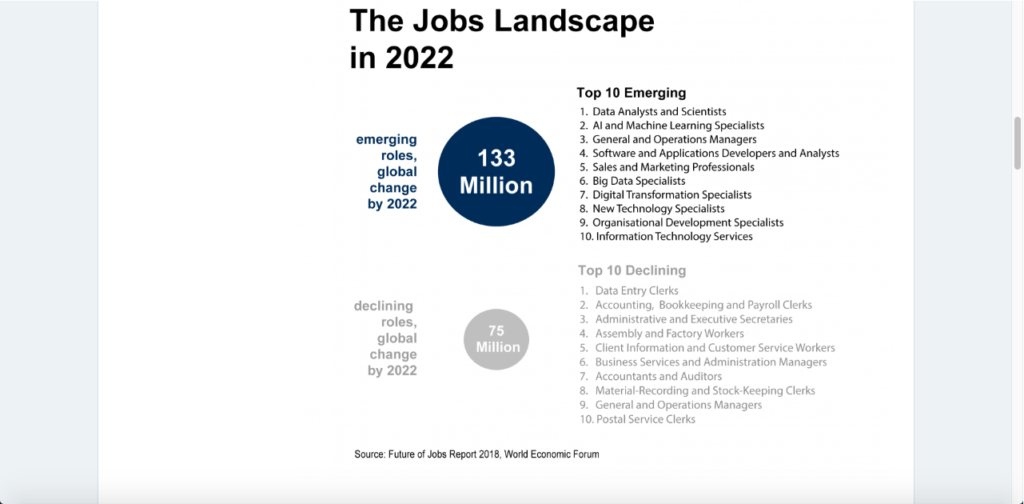Several reports from 2018 indicate that there is a skills shortage in companies engaged in artificial intelligence initiatives. According to the job portal Indeed, the number of postings have been on the rise, but there’s a huge hap between job availability and the number of searches for such positions.

Why this disconnect despite the fact that AI and machine learning jobs are expected to be the most in-demand positions by 2022, according to the World Economic Forum’s Future of Jobs Report 2018?

The same report says that 58 million net new jobs will be created because of the emergence of AI. But there’s obviously a disconnect between how AI and machine learning jobs are trending and the actual skills availability – or even interest – in the labor force.
According to World Economic Forum founder and executive chairman Klaus Schwab:
“It is critical that business take an active role in supporting their existing workforces through reskilling and upskilling, that individuals take a proactive approach to their own lifelong learning, and that governments create an enabling environment to facilitate this workforce transformation. This is the key challenge of our time.”
Businesses in various industries have been struggling with this challenge, but some of them have come to appreciate the value of a different type of learning method: gamification.
One of the ways this skills gap can be addressed is by using gamification to motivate existing employees to upgrade their skills to handle the surge in AI interest. From a long-term perspective, it can be used to create an environment that will attract the top talent in AI and its related fields.
What is Gamification?
In its simplest form, gamification is the use of game design, mechanics and principles in a non-game environment to achieve various objectives.
In the workplace, it can be used to motivate employees, upgrade their skills, recruit new talent, enhance productivity, increase employee or customer engagement, employee evaluation and many other areas.
How Gamification has Helped Accelerate Learning Programs
There are any number of case studies that show how companies have improved productivity at the workplace by employing game design and game principles.
Ford Motors in Canada, for example, saw a 417% increase in the use of its learning portals when it introduced some of the key game mechanics introduced by Bunchball’s Rajat Paharia:
-
Fast Feedback
-
Transparency
-
Goals
-
Badges
-
Leveling up
-
Onboarding
-
Competition
-
Collaboration
-
Community
-
Points
These elements have helped several other companies motivate their employees to achieve specific learning objectives that improved customer satisfaction, process completion times, implementation of learning and several other key metrics.
How Can Gamification Address the AI Skills Gap?
One innovative approach by AtkCo Inc., a learning facilitation company founded by product development expert Shayna Atkins, leverages gamification principles and AI “to measure and match skills, strengths and personality to fit roles in innovation and emerging tech.”
Such initiatives can be used in any company to motivate employees to upgrade their skills. More often than not, employees are unaware that the innate skills they possess can actually be used in an AI-centric environment, which is exactly what the AI job market needs at this point.
How Bad is the AI Skills Gap?
To backtrack a little, let’s explore this question: why is it important to explore methods like gamification to deal with the increasing shortage of skilled workers in the artificial intelligence space?
According to various estimates, there are roughly between 90,000 and 300,000 AI professionals. AI-related jobs, in contrast, number in the millions.
The problem is only going to get worse over time as the world’s top corporations step up their AI initiatives. In addition, there are hundreds of AI startups raising billions of dollars in funding. A report by CB Insights reveals that the top 100 AI startups, called the AI 100, have raised $11.7 billion from 367 funding deals. These were selected from over 2000 startups across the industry landscape.

Gamification could be one way to upgrade the labor force and save money on expensive recruitment drives for highly skilled positions in the field of artificial intelligence. According to Indeed, the average salary for a data scientist in the United States is $127,981 per year, and for a machine learning engineer that goes up to $144,442 per year.
Acquiring such talent from outside involves equally expensive overheads that can be prohibitive to all but the largest corporations or well-funded startups, which is why a relatively low-cost initiative like gamification is definitely something that companies in every industry should seriously look into.
We are now squarely in the Fourth Industrial Revolution, and we need to prepare for jobs of the future. Universities are struggling with the problem of how to prepare students for jobs that don’t even exist yet, but will exist five, ten and twenty years from now.
According to a UK government report, these are some of the recommended initiatives to address this problem:
-
An industry-funded Masters programme in AI
-
Market research to develop conversion courses in AI that meet employers’ needs
-
200 more PhD places in AI at leading UK universities, attracting candidates from diverse backgrounds and from around the world.
-
Credit-bearing AI online courses and continuing professional development leading to MScs
-
Greater diversity in the AI workforce
-
An international AI Fellowship Programme for the UK
Several such initiatives are already in place at the top universities in the United States. Centers of learning like the Stanford Artificial Intelligence Laboratory, Carnegie Mellon’s School of Computer Science and MIT’s Artificial Intelligence Laboratory are at the forefront of AI education.
Interestingly, most AI initiatives have arisen from brilliant minds in academia in the past, but the tables are being turned, and the AI industry is now the guiding force for universities to revisit their curricula and craft courses that are future-ready.
As corporations continue to invest in the tens of billions of dollars in artificial intelligence projects, we cannot ignore catalysts like gamification and their potential for accelerating development in these areas, at least from a skills acquisition standpoint.
In subsequent articles, we’ll go deeper into how gamification and artificial intelligence have complemented each other in various scenarios, one enhancing the capabilities and expanding the limitations of the other. See you soon!



